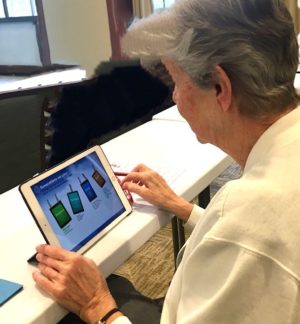Opening the Door to Online
By Robin Bush ISR Communications
Many of us are finding navigating everyday living is increasingly dependent on our ability to use the internet. What if you have never learned much about computers and trying the internet feels overwhelming?
Closing the digital literacy gap is life-changing. It assures connection to doctors, family, and friends and access to essential services, support groups, and learning and engagement opportunities. Social technologies like video calls are no longer a matter of convenience. Being connected is critical to your health, happiness, and well-being.
But let’s face it. Jumping into the big world of technology can be S-C-A-R-Y.
Do you have a computer or smartphone your adult children bought for you, but you are confused about how to use it and are embarrassed to ask them to explain it again? Or were you motivated to get online to feel less isolated during COVID and bought a computer, tablet, or phone to have Zoom chats with grandchildren but never took it out of the box? You are not alone. AARP found that older adults boosted technology purchases during the pandemic, but 54% said they needed a better grasp of the devices they’d purchased, and 37% said they were not confident using the technology. Humana did a national survey, and 46% of adults ages 65 and older have never used videoconferencing technology like Zoom. “Nearly 22 million older Americans ages 65+ lack wireless broadband access at home,” says Amanda Gimble, Dir. of Aging Connected, part of Older Adults Technology Services.
It’s OK. You can open the door and walk through with some help. There are places that provide training for seniors to improve skills, on their own time, at their own pace, alongside other seniors who are also dipping their toes into the internet world. But first, if you haven’t done it yet, you have to take your computer or tablet or phone out of the box and decide, “I can do this! I am going to turn what is scary into something F-U-N. It will be FUN to see my friends on Zoom and watch my grandchildren growing up. It will be FUN to learn to order groceries online so I don’t have to navigate the bus. It will be FUN to take a yoga class or support my brain health by learning another language.”
Next, you’ll need to set up internet service with an Internet Service provider (ISP). Don’t let this step deter you. The best ISP for you could be your local phone company, a regional provider, or a national provider. Reach out to a friend or neighbor who has internet service to find out what they do and ask them to help you get it set up. Low-income individuals may qualify for discounts through the Federal Affordable Connectivity Program (call 877-384-2575) or Internet Essentials (call 1-800-234-9473). Some providers also do not charge for internet service installation.
Once you are connected, it’s time for classes. The doors to a whole new world are about to swing wide. (Classes can help even those already reasonably familiar with their devices). Here are some excellent resources:
- For a wide range of technology classes: Senior Planet (www.seniorplanet.org) offers free courses specifically for older adults to learn to harness the power of technology to help them in their daily lives. Get Set Up, an online community for older adults, also offers technology classes (www.GetSetUp.io).
- For smartphone/tablet training: Generations On-Line (www.generationsonline.org/apps) is an online curriculum for smartphones and tablets with instructions about the Web, email, “Apps,” how to find videos and podcasts, taking and viewing photos, and more. The instructions are clear, simple, and easy to read.
You’ve got this. There have been all kinds of things you have learned in your life, and even though this is different from other skills you have mastered, it is just one more, and you know from a life of learning how much richer life becomes with new knowledge.

